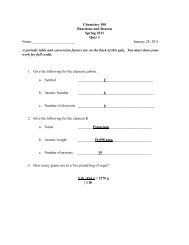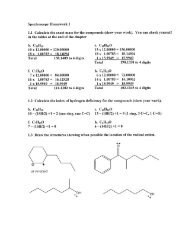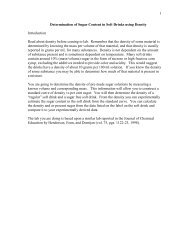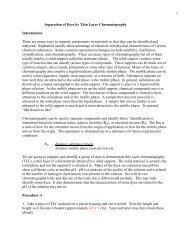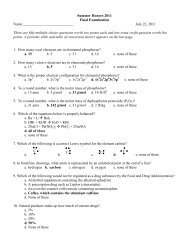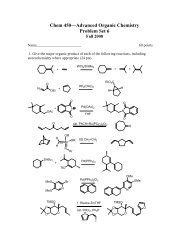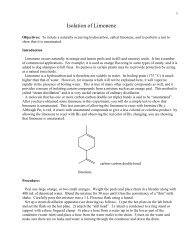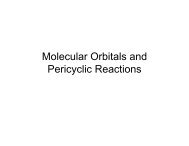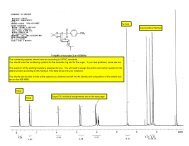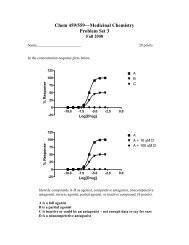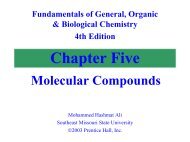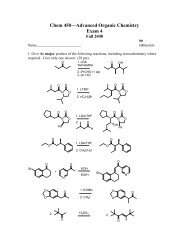Mosher Ester Analysis - Department of Chemistry and Physics
Mosher Ester Analysis - Department of Chemistry and Physics
Mosher Ester Analysis - Department of Chemistry and Physics
You also want an ePaper? Increase the reach of your titles
YUMPU automatically turns print PDFs into web optimized ePapers that Google loves.
catalyst, 4-dimethylaminopyridine (DMAP) is used. DMAP facilitates the process both<br />
by acting as a base <strong>and</strong> by forming activated acylpyridinium derivatives (below) from<br />
DCC <strong>and</strong> from the O-acylisourea. These are much more reactive as the pyridine is an<br />
excellent leaving group. This accelerates the reaction severalfold over the uncatalyzed<br />
reaction.<br />
H 3C<br />
N<br />
CH 3<br />
N<br />
N<br />
c-Hx<br />
N<br />
H<br />
c-Hx<br />
Procedure<br />
Wear gloves. DCC <strong>and</strong> DMAP are very toxic.<br />
You will be provided with a culture tube containing a scalemic solution <strong>of</strong> 6.0 L<br />
<strong>of</strong> 1-phenylethanol in 1 mL <strong>of</strong> dry CH2Cl2. To this add a stir bar <strong>and</strong> 13 mg <strong>of</strong> (R)-(+)- or<br />
(S)-(-)-MTPA as directed by your instructor. Be sure to record which enantiomer <strong>of</strong><br />
MTPA you use. Also be sure to cap the tube quickly to minimize any moisture entry<br />
after each addition <strong>of</strong> reagent. A nitrogen balloon <strong>and</strong> septum can be used if you wish.<br />
Cool the flask in an ice bath <strong>and</strong> add 12 mg <strong>of</strong> DCC <strong>and</strong> a spatula point (~1-2 mg) <strong>of</strong><br />
DMAP in sequence. Add the DCC to the reaction as soon as it is weighed as it tends to<br />
pick up moisture in the air. Stir the solution for 5 minutes in the ice bath, <strong>and</strong> then 25<br />
minutes at room temperature, during which time dicyclohexylurea will precipitate.<br />
While you are waiting on the reaction to complete, experiment with different TLC<br />
systems to determine if your reaction has finished. Spot 1-phenylethanol, DCC, DMAP,<br />
MTPA, <strong>and</strong> your reaction separately on the TLC plate <strong>and</strong> develop. Visualize the plate<br />
with UV light <strong>and</strong> circle the spots with a pencil. Begin with 1:1 hexane-ethyl acetate <strong>and</strong><br />
evaluate several mixtures until you find one that separates all <strong>of</strong> the components well,<br />
especially the product. This mixture will be used for preparative TLC to purify the<br />
product.<br />
Also while you are waiting on the reaction to complete, prepare two large test<br />
tubes for exraction <strong>of</strong> the reaction mixture. To one tube add 2 mL <strong>of</strong> 5% NaHCO3 <strong>and</strong> to<br />
the second add 2 mL <strong>of</strong> saturated NaHCO3.<br />
When the reaction is judged to be complete or 30 minutes passed, add 2 drops <strong>of</strong><br />
water <strong>and</strong> stir an additional 10 minutes. Then, add one mL <strong>of</strong> CH2Cl2 <strong>and</strong> 2 mL <strong>of</strong> 5%<br />
acetic acid to the culture tube <strong>and</strong> swirl vigorously. Using a pipet, transfer the organic<br />
layer to the test tube containing 5% NaHCO3 <strong>and</strong> swirl as before. Repeat this for the tube<br />
containing saturated NaHCO3. Prepare a pipet drying column plugged with glass wool<br />
<strong>and</strong> filled with ~3 cm <strong>of</strong> anhydrous Na2SO4. Clamp the tube in place <strong>and</strong> place a tared 10<br />
mL round bottom flask below to collect the eluent. Add the organic phase from the last<br />
tube <strong>and</strong> allow it to pass through the column <strong>and</strong> collect in the flask. Once all <strong>of</strong> the<br />
organic phase has been added <strong>and</strong> the top <strong>of</strong> the liquid reaches the Na2SO4, wash the<br />
column twice with 2 mL CH2Cl2. Remove the solvent by rotary evaporation <strong>and</strong> remove<br />
any traces under high vacuum for no more than a minute or two (The instructor will show<br />
R<br />
O<br />
N<br />
N<br />
CH 3<br />
CH 3




